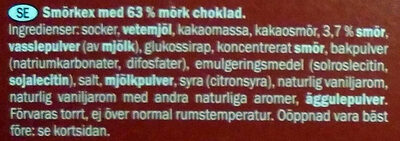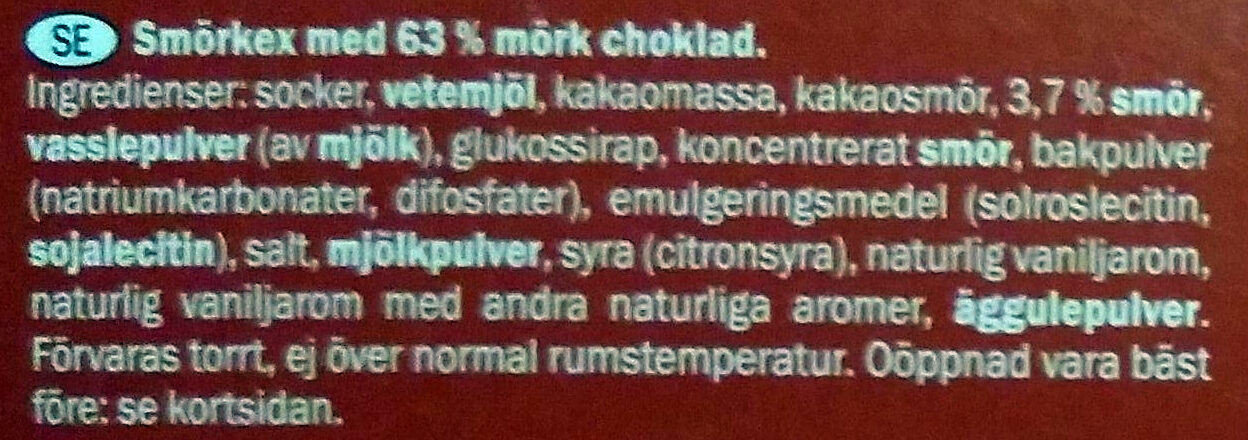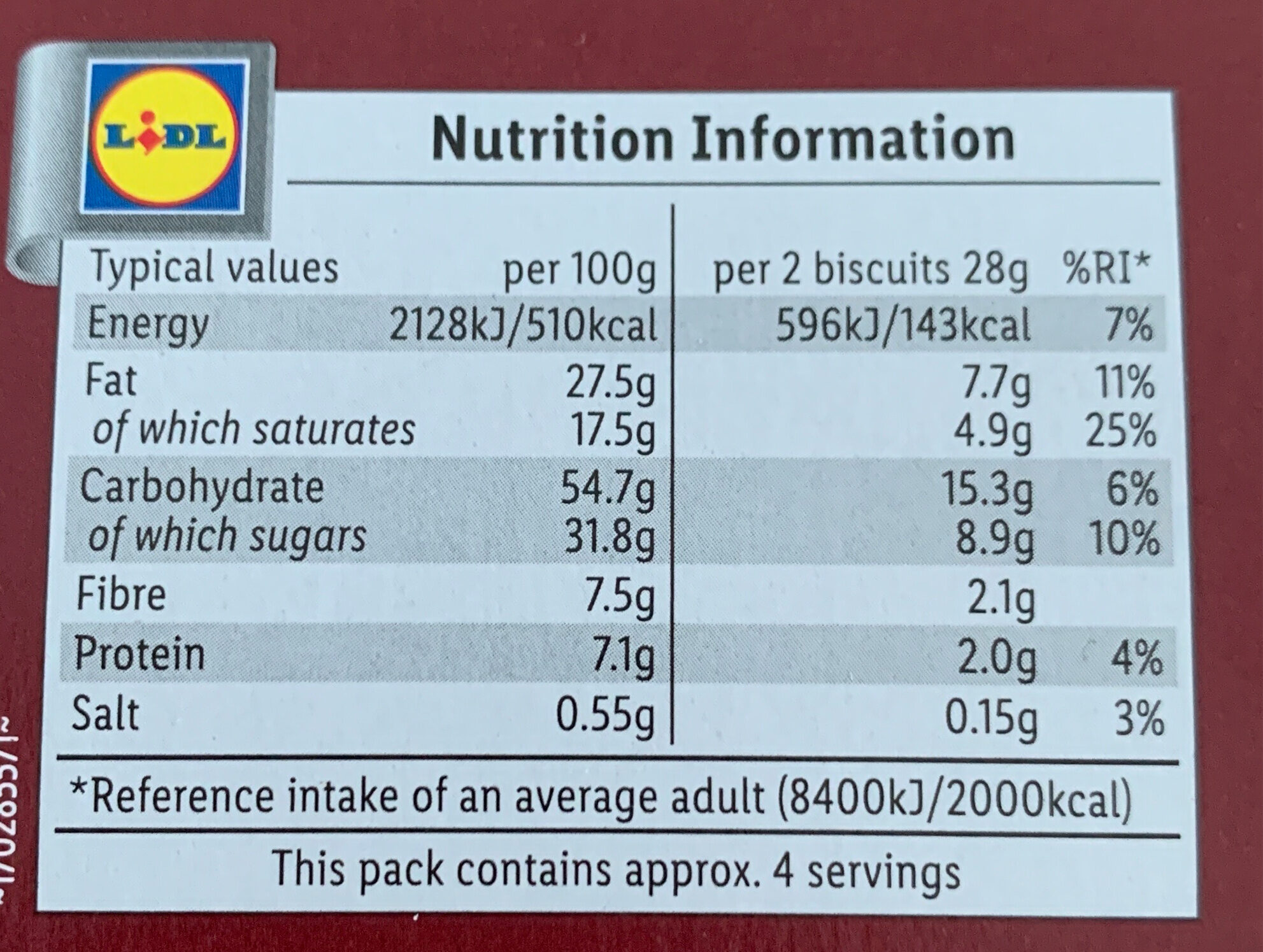Help us make food transparency the norm!
As a non-profit organization, we depend on your donations to continue informing consumers around the world about what they eat.
The food revolution starts with you!
Dark Chocolate Butter Biscuits - Sondey - 125g
Dark Chocolate Butter Biscuits - Sondey - 125g
Ambiguous barcode: This product has a Restricted Circulation Number barcode for products within a company. This means that different producers and stores can use the same barcode for different products.
×
This product page is not complete. You can help to complete it by editing it and adding more data from the photos we have, or by taking more photos using the app for Android or iPhone/iPad. Thank you!
×
Streckkod: 20026554
Kvantitet: 125g
Förpackning: Plast, Kartong, en:container, 21 PAP, 23 PBD, en:pp-polypropylene, en:card-box, en:mixed plastic-tray, en:mixed plastic-wrapper, fi:Pahvi
Varumärken: Sondey, Sondey | Lidl
Kategorier: Snacks, Söta snacks, Kakor och tårtor, Kex, en:Chocolate biscuits, en:Dark chocolate biscuits, en:Kex, en:Söta snacks
Etiketter, certifieringar, utmärkelser:
Vegetarisk, en:Sustainable farming, Tillverkad i Tyskland, en:Pure butter, en:Rainforest Alliance, Rainforest Alliance Cocoa, UTZ Certified, UTZ Certified Cocoa

Tillverknings eller bearbetningsplats: 29634 Schneverdingen, Deutschland
Butiker: LIDL
Länder där såld: Finland, Frankrike, Tyskland, Italien, Nederländerna, Storbritannien
Matching with your preferences
Hälsa
Ingredienser
-
22 ingredienser
socker, vetemjöl, kakaomassa, kakaosmör, 3.7% smör, vasslepulver (av mjölk), glukossirap, koncentrerat smör, bakpulver (natriumkarbonater, difosfater), emulgeringsmedel (solroslecitin, sojalecitin), salt, mjölkpulver, syra (citronsyra), naturlig vaniljarom, naturlig vaniljarom med andra naturliga aromer, äggulepulver.Allergener: Ägg, Gluten, Mjölk, Soja, fi:voirasva
Food processing
-
Ultra processed foods
Elements that indicate the product is in the 4 - Ultra bearbetade livsmedel och drycker group:
- Tillsats: E322 - Lecitiner
- Tillsats: E450 - Difosfater
- Ingrediens: Emulgeringsmedel
- Ingrediens: Arom
- Ingrediens: Glukos
- Ingrediens: Glukossirap
- Ingrediens: Vassle
Food products are classified into 4 groups according to their degree of processing:
- Obearbetade eller minimalt bearbetade livsmedel
- Bearbetade kulinariska ingredienser
- Halvfabrikat
- Ultra processed foods
The determination of the group is based on the category of the product and on the ingredients it contains.
Tillsatser
-
E322 - Lecitiner
Lecithin: Lecithin -UK: , US: , from the Greek lekithos, "egg yolk"- is a generic term to designate any group of yellow-brownish fatty substances occurring in animal and plant tissues, which are amphiphilic – they attract both water and fatty substances -and so are both hydrophilic and lipophilic-, and are used for smoothing food textures, dissolving powders -emulsifying-, homogenizing liquid mixtures, and repelling sticking materials.Lecithins are mixtures of glycerophospholipids including phosphatidylcholine, phosphatidylethanolamine, phosphatidylinositol, phosphatidylserine, and phosphatidic acid.Lecithin was first isolated in 1845 by the French chemist and pharmacist Theodore Gobley. In 1850, he named the phosphatidylcholine lécithine. Gobley originally isolated lecithin from egg yolk—λέκιθος lekithos is "egg yolk" in Ancient Greek—and established the complete chemical formula of phosphatidylcholine in 1874; in between, he had demonstrated the presence of lecithin in a variety of biological matters, including venous blood, in human lungs, bile, human brain tissue, fish eggs, fish roe, and chicken and sheep brain. Lecithin can easily be extracted chemically using solvents such as hexane, ethanol, acetone, petroleum ether, benzene, etc., or extraction can be done mechanically. It is usually available from sources such as soybeans, eggs, milk, marine sources, rapeseed, cottonseed, and sunflower. It has low solubility in water, but is an excellent emulsifier. In aqueous solution, its phospholipids can form either liposomes, bilayer sheets, micelles, or lamellar structures, depending on hydration and temperature. This results in a type of surfactant that usually is classified as amphipathic. Lecithin is sold as a food additive and dietary supplement. In cooking, it is sometimes used as an emulsifier and to prevent sticking, for example in nonstick cooking spray.Källa: Wikipedia (Engelska)
-
E330 - Citronsyra
Citric acid: Citric acid is a weak organic acid that has the chemical formula C6H8O7. It occurs naturally in citrus fruits. In biochemistry, it is an intermediate in the citric acid cycle, which occurs in the metabolism of all aerobic organisms. More than a million tons of citric acid are manufactured every year. It is used widely as an acidifier, as a flavoring and chelating agent.A citrate is a derivative of citric acid; that is, the salts, esters, and the polyatomic anion found in solution. An example of the former, a salt is trisodium citrate; an ester is triethyl citrate. When part of a salt, the formula of the citrate ion is written as C6H5O3−7 or C3H5O-COO-3−3.Källa: Wikipedia (Engelska)
-
E500 - Natriumkarbonater
Sodium carbonate: Sodium carbonate, Na2CO3, -also known as washing soda, soda ash and soda crystals, and in the monohydrate form as crystal carbonate- is the water-soluble sodium salt of carbonic acid. It most commonly occurs as a crystalline decahydrate, which readily effloresces to form a white powder, the monohydrate. Pure sodium carbonate is a white, odorless powder that is hygroscopic -absorbs moisture from the air-. It has a strongly alkaline taste, and forms a moderately basic solution in water. Sodium carbonate is well known domestically for its everyday use as a water softener. Historically it was extracted from the ashes of plants growing in sodium-rich soils, such as vegetation from the Middle East, kelp from Scotland and seaweed from Spain. Because the ashes of these sodium-rich plants were noticeably different from ashes of timber -used to create potash-, they became known as "soda ash". It is synthetically produced in large quantities from salt -sodium chloride- and limestone by a method known as the Solvay process. The manufacture of glass is one of the most important uses of sodium carbonate. Sodium carbonate acts as a flux for silica, lowering the melting point of the mixture to something achievable without special materials. This "soda glass" is mildly water-soluble, so some calcium carbonate is added to the melt mixture to make the glass produced insoluble. This type of glass is known as soda lime glass: "soda" for the sodium carbonate and "lime" for the calcium carbonate. Soda lime glass has been the most common form of glass for centuries. Sodium carbonate is also used as a relatively strong base in various settings. For example, it is used as a pH regulator to maintain stable alkaline conditions necessary for the action of the majority of photographic film developing agents. It acts as an alkali because when dissolved in water, it dissociates into the weak acid: carbonic acid and the strong alkali: sodium hydroxide. This gives sodium carbonate in solution the ability to attack metals such as aluminium with the release of hydrogen gas.It is a common additive in swimming pools used to raise the pH which can be lowered by chlorine tablets and other additives which contain acids. In cooking, it is sometimes used in place of sodium hydroxide for lyeing, especially with German pretzels and lye rolls. These dishes are treated with a solution of an alkaline substance to change the pH of the surface of the food and improve browning. In taxidermy, sodium carbonate added to boiling water will remove flesh from the bones of animal carcasses for trophy mounting or educational display. In chemistry, it is often used as an electrolyte. Electrolytes are usually salt-based, and sodium carbonate acts as a very good conductor in the process of electrolysis. In addition, unlike chloride ions, which form chlorine gas, carbonate ions are not corrosive to the anodes. It is also used as a primary standard for acid-base titrations because it is solid and air-stable, making it easy to weigh accurately.Källa: Wikipedia (Engelska)
Ingrediensanalys
-
Kan innehålla palmolja
Ingredienser som kan innehålla palmolja: Smörfett
-
Icke-vegan
Non-vegan ingredients: Smör, Vasslepulver, Smörfett, Mjölkpulver, Äggulepulver
-
Vegetariskt
No non-vegetarian ingredients detected
-
Details of the analysis of the ingredients
en: sugar, wheat flour, cocoa mass, cocoa butter, butter 3.5%, whey powder, glucose syrup, butter oil, raising agents (sodium carbonates), diphosphates, emulsifier (lecithins, sunflower), soya, salt, milk powder, acid (citric acid), natural vanilla flavouring, natural vanilla flavouring with other natural flavourings, egg yolk powder- sugar -> en:sugar - vegan: yes - vegetarian: yes - ciqual_proxy_food_code: 31016 - percent_min: 5.55555555555556 - percent_max: 86
- wheat flour -> en:wheat-flour - vegan: yes - vegetarian: yes - ciqual_proxy_food_code: 9410 - percent_min: 3.5 - percent_max: 44.75
- cocoa mass -> en:cocoa-paste - vegan: yes - vegetarian: yes - ciqual_proxy_food_code: 16030 - percent_min: 3.5 - percent_max: 31
- cocoa butter -> en:cocoa-butter - vegan: yes - vegetarian: yes - ciqual_food_code: 16030 - percent_min: 3.5 - percent_max: 24.125
- butter -> en:butter - vegan: no - vegetarian: yes - ciqual_proxy_food_code: 16400 - percent_min: 3.5 - percent: 3.5 - percent_max: 3.5
- whey powder -> en:whey-powder - vegan: no - vegetarian: maybe - percent_min: 0 - percent_max: 3.5
- glucose syrup -> en:glucose-syrup - vegan: yes - vegetarian: yes - ciqual_proxy_food_code: 31016 - percent_min: 0 - percent_max: 3.5
- butter oil -> en:butterfat - vegan: no - vegetarian: yes - from_palm_oil: maybe - ciqual_food_code: 16401 - percent_min: 0 - percent_max: 3.5
- raising agents -> en:raising-agent - percent_min: 0 - percent_max: 3.5
- sodium carbonates -> en:e500 - vegan: yes - vegetarian: yes - percent_min: 0 - percent_max: 3.5
- diphosphates -> en:e450 - vegan: yes - vegetarian: yes - percent_min: 0 - percent_max: 3.5
- emulsifier -> en:emulsifier - percent_min: 0 - percent_max: 3.5
- lecithins -> en:e322 - vegan: maybe - vegetarian: maybe - percent_min: 0 - percent_max: 3.5
- sunflower -> en:sunflower - vegan: yes - vegetarian: yes - percent_min: 0 - percent_max: 1.75
- soya -> en:soya - vegan: yes - vegetarian: yes - percent_min: 0 - percent_max: 3.5
- salt -> en:salt - vegan: yes - vegetarian: yes - ciqual_food_code: 11058 - percent_min: 0 - percent_max: 0.55
- milk powder -> en:milk-powder - vegan: no - vegetarian: yes - ciqual_proxy_food_code: 19044 - percent_min: 0 - percent_max: 0.55
- acid -> en:acid - percent_min: 0 - percent_max: 0.55
- citric acid -> en:e330 - vegan: yes - vegetarian: yes - percent_min: 0 - percent_max: 0.55
- natural vanilla flavouring -> en:natural-vanilla-flavouring - vegan: yes - vegetarian: yes - percent_min: 0 - percent_max: 0.55
- natural vanilla flavouring with other natural flavourings -> en:natural-vanilla-flavouring-with-other-natural-flavourings - vegan: maybe - vegetarian: maybe - percent_min: 0 - percent_max: 0.55
- egg yolk powder -> en:egg-yolk-powder - vegan: no - vegetarian: yes - ciqual_food_code: 22003 - percent_min: 0 - percent_max: 0.55
Näring
-
Bad nutritional quality
⚠ ️Warning: the amount of fruits, vegetables and nuts is not specified on the label, it was estimated from the list of ingredients: 0This product is not considered a beverage for the calculation of the Nutri-Score.
Positiva poäng: 5
- Proteiner: 4 / 5 (värde: 7.1, avrundat värde: 7.1)
- Fiber: 5 / 5 (värde: 7.5, avrundat värde: 7.5)
- Frukt, grönsaker, nötter och raps- / valnöt- / olivoljor: 0 / 5 (värde: 0, avrundat värde: 0)
Negativa poäng: 25
- Energi: 6 / 10 (värde: 2139, avrundat värde: 2139)
- Socker: 7 / 10 (värde: 31.8, avrundat värde: 31.8)
- Mättat fett: 10 / 10 (värde: 17.5, avrundat värde: 17.5)
- Natrium: 2 / 10 (värde: 220, avrundat värde: 220)
The points for proteins are not counted because the negative points are greater or equal to 11.
Näringsvärde: (25 - 5)
Nutri-Score:
-
Näringsvärden
-
Fett i hög kvantitet (27.5%)
What you need to know- A high consumption of fat, especially saturated fats, can raise cholesterol, which increases the risk of heart diseases.
Recommendation: Limit the consumption of fat and saturated fat- Choose products with lower fat and saturated fat content.
-
Mättat fett i hög kvantitet (17.5%)
What you need to know- A high consumption of fat, especially saturated fats, can raise cholesterol, which increases the risk of heart diseases.
Recommendation: Limit the consumption of fat and saturated fat- Choose products with lower fat and saturated fat content.
-
Sockerarter i hög kvantitet (31.8%)
What you need to know- A high consumption of sugar can cause weight gain and tooth decay. It also augments the risk of type 2 diabetes and cardio-vascular diseases.
Recommendation: Limit the consumption of sugar and sugary drinks- Sugary drinks (such as sodas, fruit beverages, and fruit juices and nectars) should be limited as much as possible (no more than 1 glass a day).
- Choose products with lower sugar content and reduce the consumption of products with added sugars.
-
Salt i måttlig kvantitet (0.55%)
What you need to know- A high consumption of salt (or sodium) can cause raised blood pressure, which can increase the risk of heart disease and stroke.
- Many people who have high blood pressure do not know it, as there are often no symptoms.
- Most people consume too much salt (on average 9 to 12 grams per day), around twice the recommended maximum level of intake.
Recommendation: Limit the consumption of salt and salted food- Reduce the quantity of salt used when cooking, and don't salt again at the table.
- Limit the consumption of salty snacks and choose products with lower salt content.
-
-
Näringsfakta
Näringsfakta Som såld
för 100 g / 100 mlSom såld
per portion (28g)Compared to: en:Chocolate biscuits Energi 2 139 kj
(510 kcal)599 kj
(143 kcal)+2 % Fett 27,5 g 7,7 g +8 % Mättat fett 17,5 g 4,9 g +23 % Kolhydrat 54,7 g 15,3 g −10 % Sockerarter 31,8 g 8,9 g −15 % Fiber 7,5 g 2,1 g +201 % Protein 7,1 g 1,99 g +20 % Salt 0,55 g 0,154 g +12 % Fruits‚ vegetables‚ nuts and rapeseed‚ walnut and olive oils (estimate from ingredients list analysis) 0 % 0 %
Miljö
-
Eco-Score C - Måttlig miljöpåverkan
The Eco-Score is an experimental score that summarizes the environmental impacts of food products.→ The Eco-Score was initially developped for France and it is being extended to other European countries. The Eco-Score formula is subject to change as it is regularly improved to make it more precise and better suited to each country.Life cycle analysis
-
Average impact of products of the same category: C (Score: 56/100)
Kategori: Biscuit (cookie), with chocolate, prepacked
Kategori: Biscuit (cookie), with chocolate, prepacked
- PEF environmental score: 0.47 (the lower the score, the lower the impact)
- including impact on climate change: 5.92 kg CO2 eq/kg of product
Stage Impact Jordbruk
63.6 %Bearbetar
29.8 %Förpackning
2.3 %Transportation
3.2 %Distribution
1.0 %Consumption
0.0 %
Bonuses and maluses
-
Missing origins of ingredients information
Malus: -5
⚠ ️ The origins of the ingredients of this product are not indicated.
If they are indicated on the packaging, you can modify the product sheet and add them.
If you are the manufacturer of this product, you can send us the information with our free platform for producers.
-
Packaging with a high impact
Malus: -15
Form Material Återvinning Impact Wrapper PP 5 - polypropen Hög Tray Plast Hög container 21 PAP Låg Box Okänd Hög ⚠ ️ The information about the packaging of this product is not sufficiently precise (exact shapes and materials of all components of the packaging).⚠ ️ For a more precise calculation of the Eco-Score, you can modify the product page and add them.
If you are the manufacturer of this product, you can send us the information with our free platform for producers.
Eco-Score for this product
-
Impact for this product: C (Score: 56/100)
Produkt: Dark Chocolate Butter Biscuits - Sondey - 125g
Life cycle analysis score: 56
Sum of bonuses and maluses: 0
Final score: 56/100
-
Carbon footprint
-
Equal to driving 3.1 km in a petrol car
592 g CO² per 100g of product
The carbon emission figure comes from ADEME's Agribalyse database, for the category: Biscuit (cookie), with chocolate, prepacked (Source: ADEME Agribalyse Database)
Stage Impact Jordbruk
52.9 %Bearbetar
42.0 %Förpackning
1.9 %Transportation
2.9 %Distribution
0.3 %Consumption
0.0 %
Förpackning
-
Packaging with a high impact
-
Packaging parts
Wrapper (PP 5 - polypropen)
Tray (Plast)
container (21 PAP)
Box
-
Packaging materials
Material % Packaging weight Packaging weight per 100 g of product Paper or cardboard Plast Total
-
Transportation
-
Origins of ingredients
Missing origins of ingredients information
⚠ ️ The origins of the ingredients of this product are not indicated.
If they are indicated on the packaging, you can modify the product sheet and add them.
If you are the manufacturer of this product, you can send us the information with our free platform for producers.Add the origins of ingredients for this product Add the origins of ingredients for this product
Report a problem
-
Incomplete or incorrect information?
Category, labels, ingredients, allergens, nutritional information, photos etc.
If the information does not match the information on the packaging, please complete or correct it. Open Food Facts is a collaborative database, and every contribution is useful for all.
Datakällor
Produkt tillagd den av tacite-mass-editor
Senast ändrad produktsida på av prepperapp.
Produktsida också redigerad av dahlqvist, date-limite-app, halal-app-chakib, inf, jumati, kiliweb, martinshadok, mhk-off, narekor, openfoodfacts-contributors, packbot, puravida, sebleouf, smoothie-app, swipe-studio, tacite, yuka.YTU4TUtmdGRuY0UwbGMwdjEwL1IzODVGd01Ha2MwZXNHc29CSVE9PQ, yuka.sY2b0xO6T85zoF3NwEKvlhNjacWFrxDUFgDWmVWP2_6tN67mP49UzKrjaqo, yuka.sY2b0xO6T85zoF3NwEKvlmxYQ8eOvTzcGjrfgEyL5tSKdozxXoxyybbjL6g.












